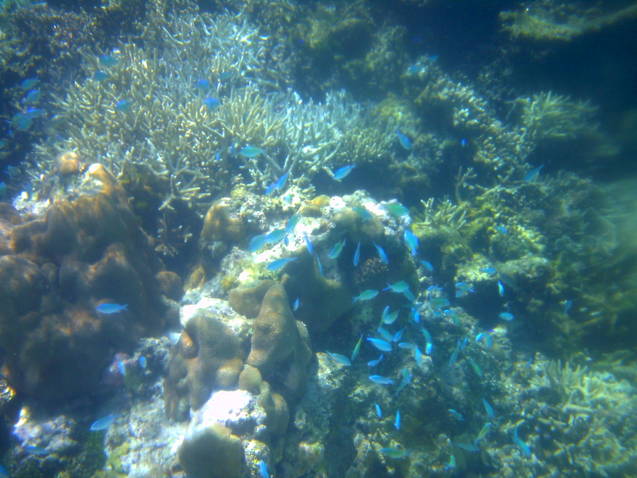I knew, when I broke my ankle back in September, that it would be a while before I was ready to declare myself healed. That was the third time I had broken my right ankle, in just about the same place, and true to form, I tore up ligaments and tendons and everything. Well, the ankle isn’t back to whatever normal used to be, but it’s getting there, thanks to what I call my salt water therapy – swimming.
 |
| Approaching a beach resort by boat. Jealous yet? |
 |
| One of the other senior missionaries getting into the water. |
 |
| If you look at the colors of the water, you can tell where it's deep (more blue) or shallow (more green). |
 |
| An artificial reef and a playground - kids climb up on the point and jump off into the water! |
But when we find a calm moment to explore, the rewards are worth it. There are hulks of old ships dotting the reefs, cast up beyond a reef during a storm, or pierced by a reef and sunk against it. Many of them have prows that rise above the surface, and provide local landmarks (“Look out past the blue wreck, and you can see that heron…”) and every one of them has served as an artificial reef, becoming a home for small shoreline sea creatures like angelfish and hermit crabs.
 And when we’re swimming and see an old truck tire encrusted with coral, we’re amazed at how the ocean systems seem to recycle everything – anything that’s on the bottom becomes a home for some creature. This coral formation was very near that tire – found the coral again, when I went back for the camera, but couldn’t find the tire!
And when we’re swimming and see an old truck tire encrusted with coral, we’re amazed at how the ocean systems seem to recycle everything – anything that’s on the bottom becomes a home for some creature. This coral formation was very near that tire – found the coral again, when I went back for the camera, but couldn’t find the tire! 
When the clouds hide the sun, everything underwater takes on a green hue, but it’s still pretty. And this was one of about a dozen fish like it – I have no idea of the English name of the fish, but I remember the Hawaiian name, just because it’s so long: humu-humu-nuku-nuku-apu-a’a. Glad I finally got to see one up close and in person!
But when the sun comes out, the colors are amazing. The amount of life in these shallow waters is overwhelming – and fascinating. (I can’t take credit for this picture – one of the other senior missionaries has a real underwater camera, not just a generic case over a regular camera.)
Well, when we get tired of the water, there’s always the beach. Just crash, like this guy, who will remain unidentified to all except those who love him best. Cool breeze, shade and sun as you wish – do we really have to leave?
 |
| You can see that the "sand" is crushed coral, on our beaches. |
 |
| Maui is one of these faces, but I haven't found out which one yet. He's also a demi-god in Hawaii. |
Whether Maui or tectonic forces shaped this island, it’s a wonderful place to be. And the salt water therapy? I’m kind of hoping it takes another 20 months to have its full effect.


I'm trying not to be jealous...unless, of course, it stops being a sin! You deserve this, not the ankle, of course, the beautiful surroundings! It seems that one could never be bored, with so much to see there, and it all seems to change! Can you post that pic of Maui, that would be neat! I hope your salt water therapy is successful in the way things go in Tonga, peaceful and paced nicely. And that you and Jim enjoy every minute!
ReplyDeleteLike I said in the Falls Church FB page, it's a sacrifice, but it's one I think I can make...haha. I'll try to find an image of Maui. The guy at the craft stall at the downtown market probably can tell me which one is Maui. I won't be able to do it this week, though - I'm in meetings all week. Soon, I promise.
DeleteIt’s good to hear that you've found a great way to help your broken ankle recover. When my daughter got her knee injured, her doctor advised her to take swimming as well as a simple form of keeping her body on the go and, at the same time, allowing herself to get better slowly but surely. Swimming is an efficient way to keep your muscles active and a good means to rebuild your flexibility and strength.
ReplyDeleteLani Waugh